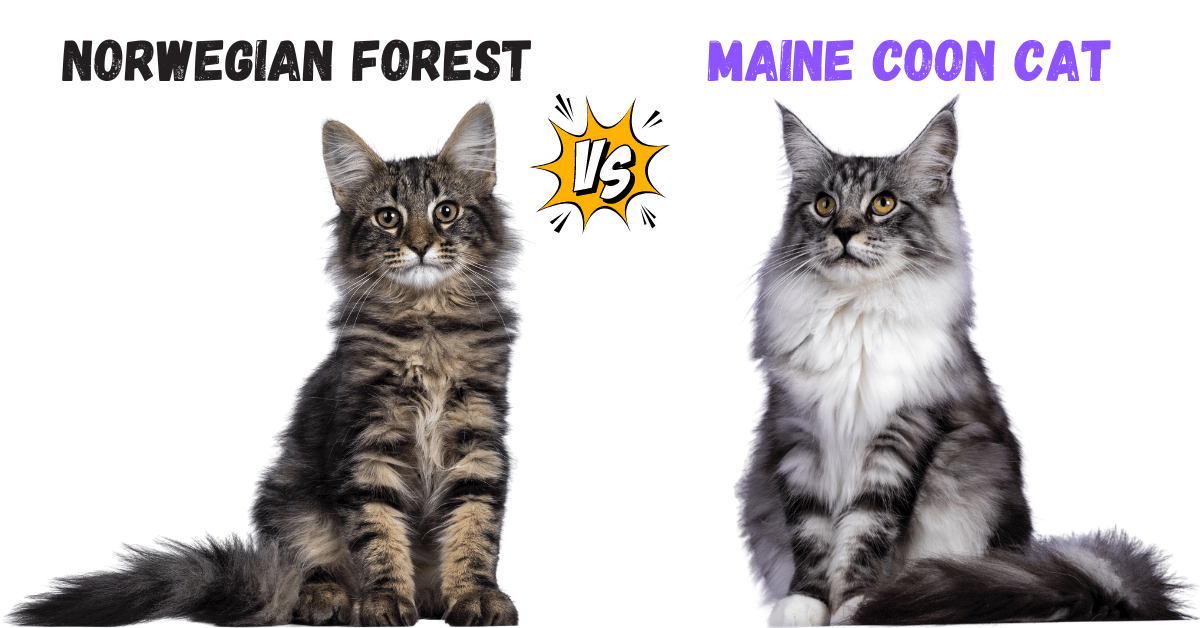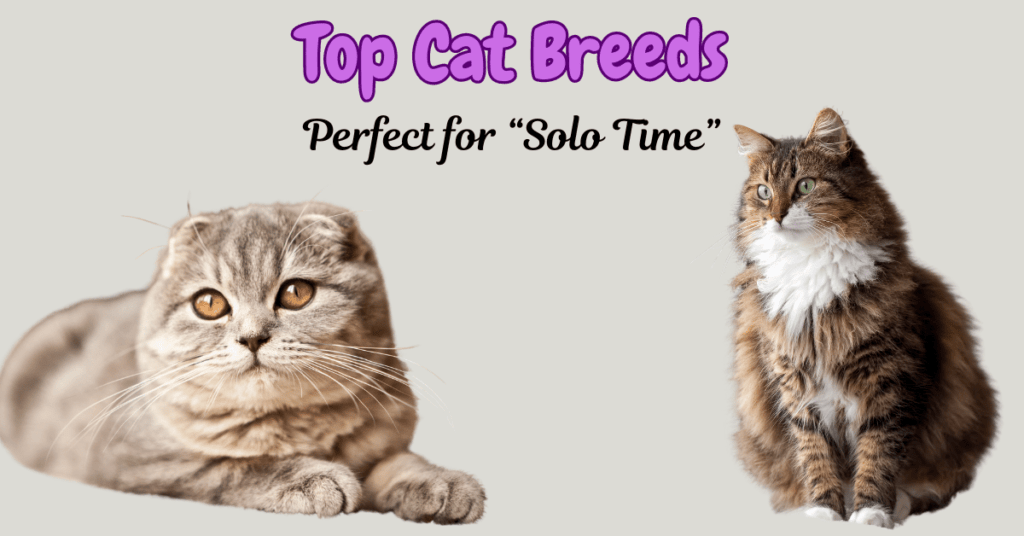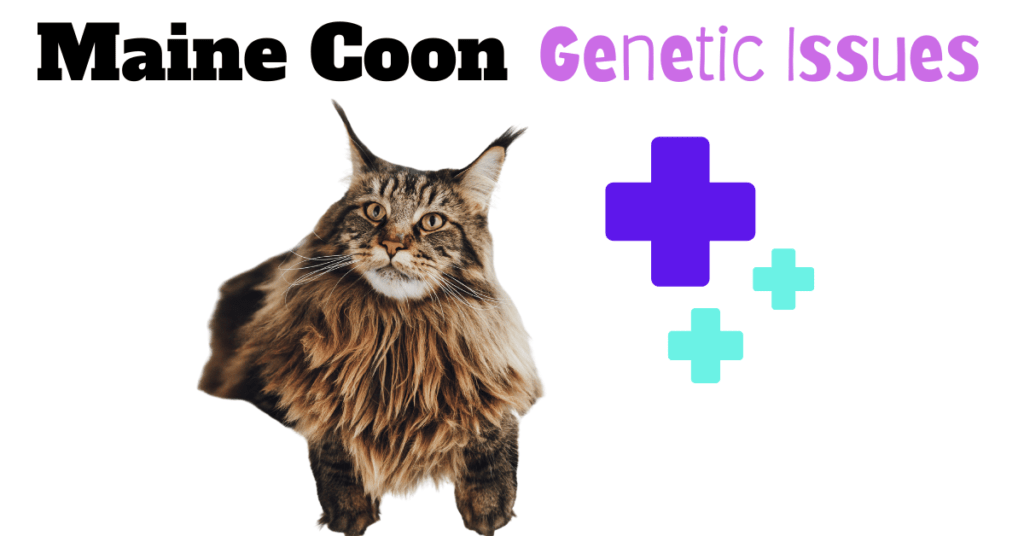This post contains affiliate links and I will be compensated if you make a purchase after clicking on my links.
Norwegian Forest Cat vs Maine Coon: An In-Depth Comparison
At first glance, Norwegian Forest Cats and Maine Coons may appear strikingly similar, leading one to think they’re the same breed. However, their rustic, long-haired exteriors belie distinct traits and rich histories that differentiate them. Some enthusiasts even believe that the Norwegian Forest Cat is the direct ancestor of the Maine Coon.
This post delves into an in-depth comparison between these two magnificent breeds, exploring their origins, physical attributes, personalities, and care needs to help you appreciate their uniqueness.
Exploring the Origins of Norwegian Forest Cats and Maine Coons
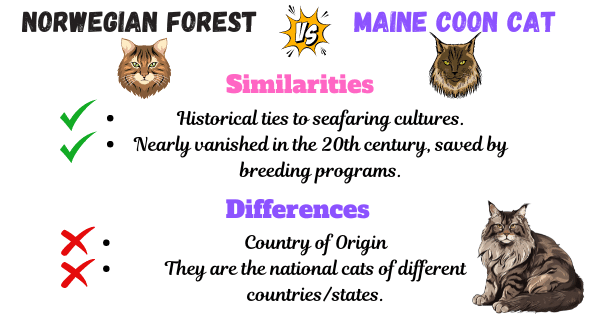
Norwegian Forest Cat
The Norwegian Forest Cat, affectionately known as the “Wegie,” originates from the cold and rugged landscapes of Scandinavia. Its history intertwines with Viking lore, having been a popular companion and an efficient mouser on long sea voyages during the Middle Ages.
These cats are believed to have Middle Eastern semi-longhair ancestors, which adapted to the harsh Scandinavian winters over centuries, developing a thick, water-resistant coat and a sturdy physique. Known in their homeland as “Skogkatt,” which means forest cat, these felines are not just pets but a part of ancient Nordic mythology.
Legends depict them as the chosen steeds of the goddess Freya’s chariot. Despite nearly vanishing in the 20th century, dedicated breeding programs initiated in the 1930s helped preserve this breed, leading to its official recognition and cherished status as Norway’s national cat.
Maine Coon
On the other side of the Atlantic, the Maine Coon’s tale begins in the northeastern United States, specifically Maine, which it is named after and serves as the official state cat. The breed’s origin stories are varied and colorful, including theories that they descended from cats brought over by the Vikings, making them distant relatives of the Norwegian Forest Cat.
Another popular theory suggests that they are the descendants of long-haired cats belonging to Marie Antoinette, sent to America ahead of her failed escape from France. What is known for certain is that Maine Coons were invaluable to early American settlers for their hunting prowess and sociable nature, traits that made them favorites on farms and in households.
Rediscovered in the mid-20th century following a period of declining popularity, the Maine Coon has regained prominence. Celebrated for its friendly nature and striking, lion-like mane, it was officially recognized by the CFA in 1967.
Physical Differences Between Norwegian Forest Cats and Maine Coons

Body Shape and Size
While both breeds are large and muscular, there are notable differences that distinguish them. The Maine Coon is one of the largest domesticated cat breeds, with males typically weighing between 15 and 25 pounds, and females slightly smaller, ranging from 10 to 15 pounds. They are characterized by a broad, powerful chest and medium-length legs, which give them a robust and rugged appearance.
In contrast, the Norwegian Forest Cat, though also large, tends to be slightly slimmer than its American counterpart. Males generally weigh between 13 to 20 pounds and females from 12 to 15 pounds. Their body is more streamlined, with high legs that are longer at the back, giving them a regal stance that echoes their mythical heritage.
Fur and Coat
Both breeds boast beautiful semi-long fur that serves as protection against their native harsh climates. The Maine Coon has a silky uppercoat with a fine, soft undercoat, making their fur slightly less dense but still plush. This breed’s fur is also known for its slight oiliness, which adds a water-resistant quality beneficial for snowy environments.
The Norwegian Forest Cat’s coat, meanwhile, is adapted for survival in the cold Scandinavian weather. It features a dense, wooly undercoat and a glossy, water-repellent upper coat. Notably, the Norwegian must have a mane that resembles that of a lion, adding to their wild, majestic look.
Fact: Both breeds can come in any color variety except for pointed patterns, chocolate, lilac, cinnamon, and fawn. Additionally, the amber category is not found in Maine Coons.
Head and Facial Features
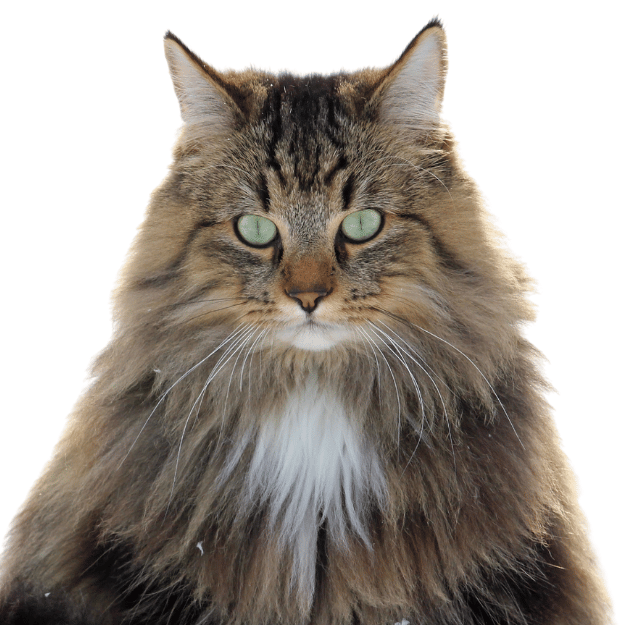
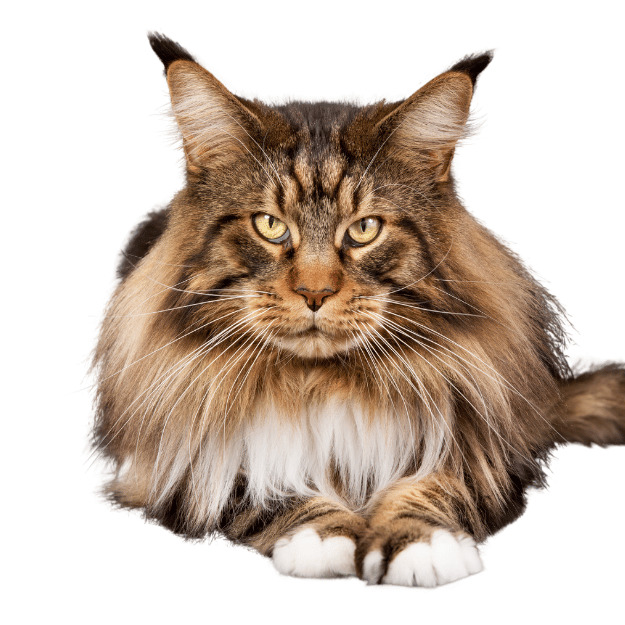
The head shapes of these two breeds further reflect their distinctiveness. The Maine Coon has a slightly elongated face with a square muzzle and a gentle concave curve in its profile. Their large, expressive eyes are slightly oval but appear round when fully open.
The Norwegian Forest Cat’s head is shaped almost like an equilateral triangle, with a long, straight profile from the tip of the nose to the slightly rounded forehead. Their eyes are large and almond-shaped, conveying an alert and intelligent expression.
Ears
Ears in both breeds are large, with possible lynx tips adding an element of the wild to their appearance. The Maine Coon’s ears are set high on its head, while the Norwegian’s ear line follows the triangular shape of the face, enhancing their sharp, angular aesthetic.
Personality and Behavioral Traits: Norwegian Forest Cat vs Maine Coon
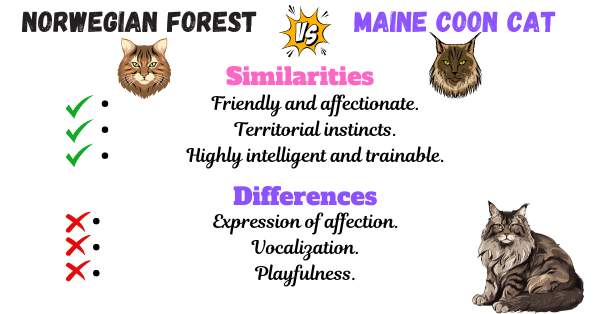
General Personality
Both Maine Coons and Norwegian Forest Cats are known for their friendly and affectionate natures, making them excellent companions in any household.
However, their ways of expressing affection differ. Maine Coons are more overtly affectionate, often running to the door to greet you and enjoying cuddles in your lap, making them more of a typical lapcat.
In contrast, Norwegian Forest Cats show loyalty and attachment without the need for constant physical closeness. They are less clingy and value their independence, often preferring to show their affection in less direct ways.
Communication Styles
Maine Coons are more vocal, using chirps and trills to communicate their happiness or need for attention. Norwegian Forest Cats, on the other hand, are quieter and calmer, typically using soft, gentle voices and often purring loudly to express contentment.
Territorial Behavior and Socialization
Both breeds exhibit territorial instincts and can be dominant, which is manageable with proper socialization from a young age. Introducing them to other pets during kittenhood can help mitigate dominance issues and promote harmonious relationships.
Trainability and Intelligence
Maine Coons and Norwegian Forest Cats are highly intelligent and responsive to training, often compared to dogs in their ability to learn tricks and engage in games like fetch and hide-and-seek. Their smart and trainable nature makes them engaging pets that can perform various commands and participate actively in family activities.
Health, Lifespan, and Breed-Specific Concerns
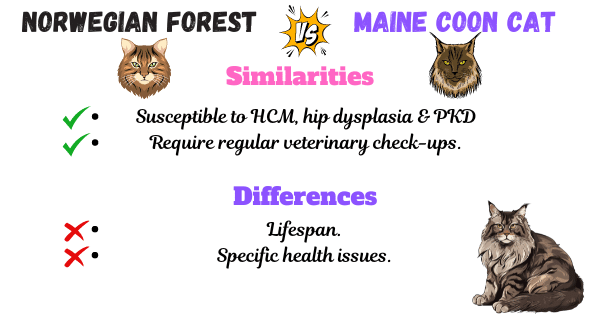
Common Health Issues
Norwegian Forest Cats and Maine Coons share susceptibility to several significant health issues that require careful monitoring and management. These include:
- Hypertrophic Cardiomyopathy (HCM): The most common heart disease in cats, HCM involves the thickening of the heart muscle. This condition can impair heart function and potentially lead to severe complications, including blood clots, fluid accumulation in the lungs, and heart failure.
- Hip Dysplasia: Common in larger cat breeds, hip dysplasia can lead to arthritis and might require surgical intervention in severe cases. Regular veterinary checks can help manage this condition effectively.
- Polycystic Kidney Disease: A genetic condition that progressively damages the kidneys, reducing their function over time and potentially leading to renal failure.
Norwegian Forest Cats: Specific Health Concerns
Norwegian Forest Cats typically enjoy a lifespan of 14 to 16 years. Apart from common health issues, they are also at risk for glycogen storage disease type IV, a rare genetic disorder that impacts glucose metabolism, potentially leading to early mortality in kittens.
Another specific health issue for this breed is retinal dysplasia, an eye condition that may cause spots on the retina. While it can be alarming, it generally does not significantly impair vision.
Maine Coons: Specific Health Concerns
Maine Coons typically have a slightly shorter lifespan, ranging from 12 to 15 years. In addition to common health issues, they are prone to spinal muscular atrophy, a genetic condition that affects the skeletal muscles. This condition can influence how a cat moves but is usually not painful. These specific issues necessitate vigilant monitoring for joint health as these cats age.
Lifestyle-Related Health Considerations
For both breeds, lifestyle plays a significant role in their overall health. Regular exercise, diet management, and mental stimulation are critical to preventing obesity and related health problems like diabetes and joint stress, particularly in breeds prone to joint issues like the Maine Coon.
Tip: Regular veterinary check-ups are crucial for both breeds to manage health issues early. Owners should ensure routine screenings for heart conditions and joint problems, particularly as the cats age. With proper care, Maine Coons and Norwegian Forest Cats can often live beyond their typical lifespan, sometimes up to 20 years or more.
Exercise and Activity
Maintaining an active lifestyle is essential for both breeds. Regular play and exercise not only help in managing weight but also contribute to overall physical and mental health.
Maine Coons tend to remain playful and energetic longer than Norwegian Forest Cats, who may become more sedentary as they age. Owners should encourage play and provide stimulating environments to keep them engaged and active.
Tip: Aim to dedicate at least 30 minutes each day, though ideally, engaging them twice daily will help keep them at their happiest and healthiest.
Diet and Nutrition
Maine Coons and Norwegian Forest Cats require a diet rich in high-quality proteins, including lean meats and fish, to meet their nutritional needs. The primary difference between the two lies in portion size, as the larger Maine Coons need more calories. Both breeds benefit from a balanced diet that supports their muscular build and dense fur.
It’s important to cater the diet to their specific needs, taking into account factors like age and activity level. A mix of wet and dry food is ideal: wet food provides more animal protein and hydration, helping prevent urinary and kidney issues, while dry food can be useful for dental health, serving as an occasional snack to help keep teeth and gums healthy.
Norwegian Forest Cat vs Maine Coon: Grooming Needs
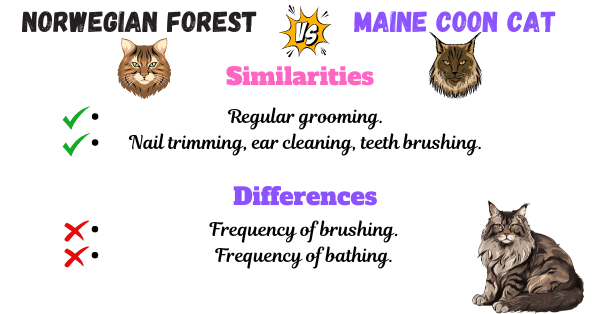
Brushing
While both the Norwegian Forest Cat and Maine Coon require regular grooming to maintain their health and appearance, their specific needs differ slightly due to the nature of their coats. Both breeds shed a lot, but their fur quality is different.
Maine Coons, with their dense and plush fur, are prone to tangling and matting. To manage this, they need to be brushed two to three times a week, which helps remove loose hair and prevents knots from forming.
In contrast, the Norwegian Forest Cat’s coat is water-resistant and doesn’t mat as easily, requiring only weekly brushing under normal circumstances. However, during the molting season, when shedding increases, more frequent grooming might be necessary to keep their fur in good condition.
Bathing
Bathing routines also vary between these breeds due to differences in their fur’s texture and quality. Maine Coons may require monthly baths, especially if they spend time outdoors and get dirty.
Norwegian Forest Cats, on the other hand, have coats that repel water, making bathing a bit more challenging. They typically need a bath every few months, or as needed when they become dirty. Some owners find it easier to handle this task with the help of a professional groomer to ensure the coat is thoroughly and properly cleaned.
Other Grooming Requirements
Beyond these specific grooming tasks, both breeds benefit from the same basic care practices. Regular nail trimming, ear cleaning, and teeth brushing are essential to prevent health issues and maintain overall well-being.
These routine care steps are crucial for keeping your cat healthy and also provide an excellent opportunity to strengthen the bond between you and your pet.
Making the Right Choice: Norwegian Forest Cat vs Maine Coon
Norwegian Forest Cats and Maine Coons are not just visually stunning but also fascinating examples of Bergmann’s Rule. This biological principle suggests that warm-blooded animals in colder climates tend to be larger and bulkier, helping them retain body heat more effectively. Both these cat breeds exemplify this rule with their robust bodies and dense fur, traits that have evolved to protect them against harsh climates.
Ultimately, whether you lean towards the stoic beauty of the Norwegian Forest Cat or the sociable charm of the Maine Coon, both breeds make exceptional companions. Each cat, regardless of breed, possesses a unique personality that may vary significantly from the general breed characteristics.
It’s essential to remember that the beauty of having a pet lies not just in its aesthetic appeal but in the joy and companionship it brings into your life.
Meet Sean, a fintech whiz with a penchant for pet purrs and blockchain buzz. After a decade of fintech feats, Sean’s tech talents leaped from ledger lines to litter lines, driven by a passion for pets and a vision for a more connected pet care community. With three critter companions as co-pilots, Sean launched this blog to share a treasury of pet-friendly tech tips and tales.

